Sweet gooseberry with dark red Hinnonmaki Red
Hinnonmaki Red is one of the varieties of the Hinnonmaki gooseberry variety, which has many positive characteristics: drought and frost resistance, large-fruited and pleasant berry taste. We will tell you in detail how to grow this variety so that the bushes develop well and bear fruit abundantly.
The content of the article
Features of the variety
This is a medium-early ripening gooseberry variety... The bushes bear fruit within a month, starting in mid-summer. Productivity - 7-8 kg per bush.
The first harvested, not fully ripe berries at a temperature of 0 ° C are stored for up to 40-45 days; ripe, filled with bright red color and gaining juiciness and sugar content - 3-4 days.
History of origin and distribution
Hinnonmaki gooseberry brought out by Finnish breeders in the 80s of the XX century... The goal of the scientists was to obtain a fundamentally new, productive, frost, drought and disease-resistant variety of culture.
On the basis of the resulting variety, breeders have created fruit shrubs with multi-colored berries. One of them is the Hinnonmaki Red gooseberry (Hinnonmaki Rot, Hinnonmaki Rod).
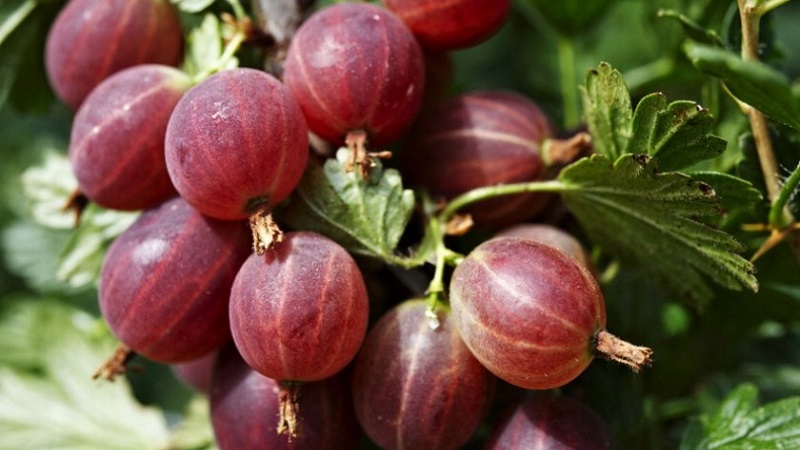
Characteristics and description of the bushes
Bushes are fast-growing, moderately branched, up to 1.8 m high with strong erect shoots covered with gray or gray-brown peeling bark. Branches and shoots are covered with short needle-like thorns.
Medium sheet plates, three- or five-lobed, dull green.
During flowering in the leaf axilslocated on the upper parts of the stems, there are few racemose inflorescences, consisting of two or three buds.
Resistant to temperatures
Frost-resistant variety - bushes without damage tolerate a drop in air temperature to -30 ... -34 ° C.
Moisture and drought resistance
Thanks to a powerful and deep root system the plant tolerates heat well and can do without watering for up to 30 days.
Hinnonmaki Red is not moisture resistant - with excessive watering, plant roots begin to rot.
Disease and pest resistance
The variety is resistant to septoria and powdery mildew... With improper care and unfavorable conditions, it can be struck by anthracnose, white spot, gray rot, goblet rust, root cancer.
Of the pests, the bushes attack spider mites, moths, sawflies, currant gall midges, aphids.
Characteristics and description of fruits
Berries are oval, almost round, large (weighing 7-7.5 g), covered with a thin but strong skin, which, after ripening, acquires a dark red color with stripes.
The pulp is transparent, characterized by a sweet taste... But when combined with the sour skin, the Hinnonmaki Red fruit doesn't seem sugary.

Application area
Berries are consumed fresh, used for cooking desserts, compotes, jelly, marmalade, preserves, jams and even homemade wine.
Other gooseberry varieties:
Advantages and disadvantages compared to other varieties and hybrids
The main advantages of the variety:
- rapid growth of bushes;
- high productivity;
- large-fruited;
- pleasant taste and aroma of berries;
- drought and frost resistance;
- immunity to certain diseases;
- lack of tendency to crack fruit;
- good keeping quality and transportability;
- the possibility of mechanized harvesting.
Among the disadvantages of Hinnonmaki Red are the presence of multiple thorns on the stems and a tendency to shedding ripe berries.
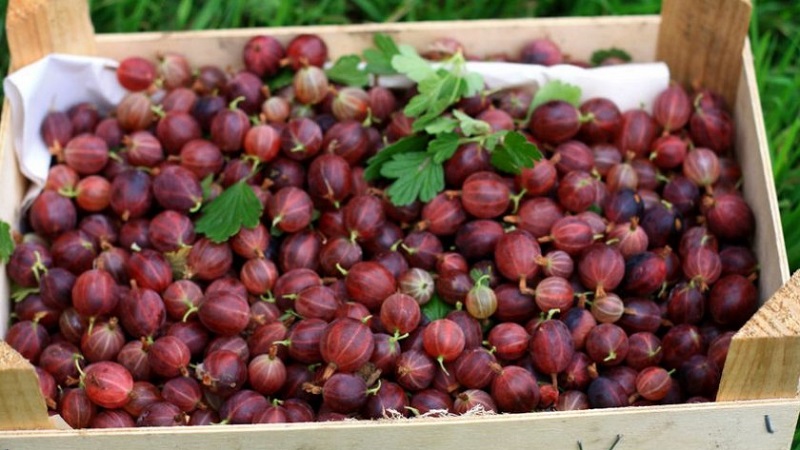
Growing technology
In order for the seedlings to take root, begin to develop and bear fruit, it is first of all important to correctly plant - choose a suitable place on the site, prepare the land and planting material - and properly care for the plants.
Optimal conditions
The bushes are planted in a well-ventilated and well-lit place.... The variety prefers fertile, loose soil with good moisture and air permeability and neutral or weak acidity. The best option is loam and sandy loam.
Reference. In the shade, the bushes develop poorly, and the crop yield decreases.
The landing site should be located on a hill, the depth of groundwater is at least 1 m.
When buying planting material, seedlings are chosen without signs of damage. stems or root system, with fibrous developed roots and at least three strong elastic shoots, which are shortened to 10 cm before planting.
For better rooting, seedlings are soaked for a day in a solution of a growth stimulator ("Kornevin", "Heteroauxin").
Terms and rules of landing
Planting is carried out in the spring, at the end of March, or in the fall, from the second decade of September until mid-October, so that the bushes have time to take root and take root before frost.
Landing rules:
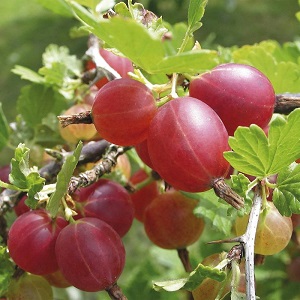 Two weeks before planting, dig planting holes on the site with a diameter of 50 cm and a depth of 20-25 cm at a distance of 1.5-2 m from each other.
Two weeks before planting, dig planting holes on the site with a diameter of 50 cm and a depth of 20-25 cm at a distance of 1.5-2 m from each other.- Pour into each nutrient mixture (half of the excavated soil, a bucket of manure, 300 g of ash and 200 g of mineral fertilizers).
- Form a small hill in the hole, place a seedling on it and spread its roots along the slopes.
- Cover the voids with earth so that the root collar is buried by a maximum of 5 cm.
- Tamp and water the soil, add more soil, form a hole around the bush and water again, spending 5 liters of water per seedling.
- Mulch the soil with peat.
Further care
For the first time, the bushes are watered 10-15 days after planting, then - once a week at the rate of 8 liters of water under a bush.
Reference. The best way to irrigate is drip.
After watering, the soil is loosened to improve aeration and moisture permeability... Weeding is carried out at the same time.
Provided that seedlings are planted in nutrient soil and fertilized into the holes they start feeding the plants after two years according to the following scheme:
- March-April - compost, rotted manure (5-6 kg per bush) and spraying with a solution of mineral fertilizers (20 g each of potassium, ammonium nitrate and superphosphate per bucket of water) at the rate of 1-1.5 liters per plant;
- May - mineral fertilizers (for example, "Ammophos", "Kemira");
- end of June - 1 liter of slurry (a bucket of manure, a quarter of a bucket of compost per 100 liters of water), diluted in a bucket of water;
- autumn - 5-6 kg of compost or humus and a mixture of 1 liter of wood ash, 120 g of simple superphosphate and 100 g of potassium sulfate under a bush.
Pruning is done twice a year.... In early spring, damaged, poorly overwintered branches are removed, and weak shoots are shortened by 10-15 cm. In autumn, after harvesting, shoots older than 6 years are cut off, leaving a maximum of 15 strong and healthy stems on the bush.
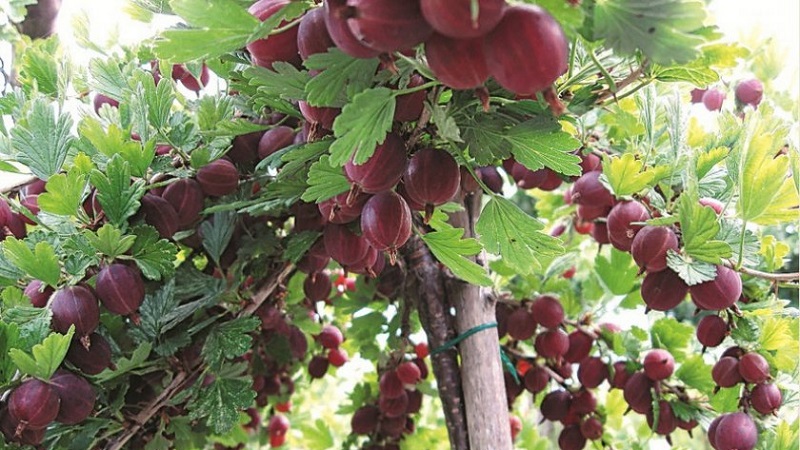
So that during fruiting, the branches do not fall to the ground, and the harvest is easier to harvest, use trellis support. To do this, wooden stakes are driven in at the edges of the bushes, between which the wire is pulled in three strips so that the lower one is 0.5 m above the ground, the middle one is 0.8 m, the upper one is 1.2-1.3 m.
For prevention diseases and pests timely remove damaged and dry stems, weed and loosen the soil, treat the bushes with insecticidal and fungicidal preparations, using iron vitriol or "Prophylactin" until the buds swell and "Fitoverm" or "Fitosporin" during budding.
Possible problems, diseases, pests
Diseases and pests affecting Hinnonmaki Red are described in the table:
| Disease, pest | Signs | Treatment |
| Anthracnose | Dark brown spots form on the leaves, gradually the leaf plates darken and fall off. | Treatment of bushes with fungicidal preparations, for example, "Karbofos" or "Topaz". |
| White spot | Light spots appear on the leaves with dark edges and dots with spores in the middle. In the middle of the growing season, the leaves dry out, crumble and fall off. | |
| Gray rot | A light bloom appears on the leaves and shoots. | |
| Goblet rust | Bright orange swellings appear on the leaves and shoots, the shoots are bent. | |
| Root cancer | Growths form on the rhizome, the plant dies. | There is no cure. The affected bushes are dug up and burned. |
| Spider mite | The inner side of the leaves is covered with a thin web, the leaves dry up and fall off. | Insects are fought with the help of preparations "Fufanon", "Aktara", "Karbofos", "Iskra", "Gardona", "Fitoverm". |
| Fire | The bushes are lagging behind in development and lose their ovaries. | |
| Sawfly | Ovaries are damaged by insects, berries and seeds are damaged by their larvae. | |
| Currant gall midge | Branches, leaves and ovaries dry out on the bushes. | |
| Aphid | The internodes are noticeably deformed. |
Wintering
In autumn, after pruning bushes, the soil is weeded, loosened and cleaned of plant residues and other rubbish. Plants are watered abundantly (3-4 buckets under a bush), and sprayed with Bordeaux liquid to protect against pests. The land is mulched with peat or humus.
Due to frost resistance, plants are not covered for the winter. - they only need a layer of mulch and sprinkle with snow.
Reproduction
Bushes are propagated by cuttings or layering... In the first case, at the end of summer, a healthy branch is selected and cut into pieces no more than 15 cm long. The resulting cuttings are soaked for a day in a growth stimulant solution, then planted in moist and loose soil and germinated under a film at a temperature of + 28 ... + 30 ° C ... They are planted in a permanent place in the spring.
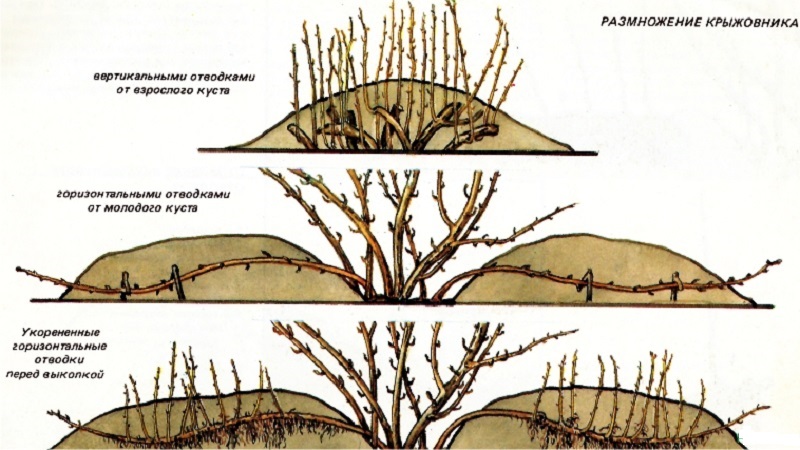
For reproduction by layering in early spring, strong lateral stems are chosen., bend them to the ground, lay them in shallow (up to 10 cm) dug trenches and fix them. After the appearance of a young growth, the trenches are sprinkled with soil. After rooting, the layers are separated from the mother bush and transplanted.
Features of growing varieties depending on the region
The variety tolerates heat and drought as well as frost, therefore, it is successfully grown in all regions, without making significant adjustments to the rules for planting and caring for bushes.
Pollinating varieties
Hinnonmaki Red is a self-fertile variety, that is, pollinated with its own pollen... At the same time, planting different varieties of crops nearby helps to increase yields.
Reference. For better pollination, gooseberries are treated with "Boron Chelatom" and "Maxicrop".
Reviews of summer residents
Summer residents are happy with the Hinnonmaki Red gooseberry, which is confirmed by their reviews.
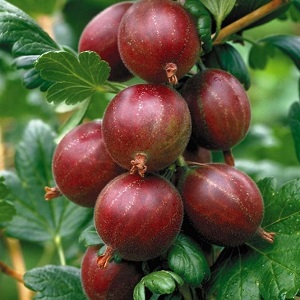 Maxim, Leningrad region: “I have been growing this gooseberry for 6 years. The bushes winter well without shelter, bear fruit regularly and abundantly, the berries are formed large, dense, beautiful and tasty ".
Maxim, Leningrad region: “I have been growing this gooseberry for 6 years. The bushes winter well without shelter, bear fruit regularly and abundantly, the berries are formed large, dense, beautiful and tasty ".
Elena, Yelets: “I really like this variety. It is unpretentious, self-pollinated and large-fruited. The berries are beautiful and delicious. Of the minuses, I note that for some reason I have already failed twice to propagate the bushes by cuttings - they do not take root at all. But they reproduce well by layering ".
Conclusion
The gooseberry variety Hinnonmaki Red bears fruit stably with minimal maintenance, does not need pollinating varieties, and is able to withstand drought and frost.
The berries have a pleasant sweet taste with a slight sourness and are suitable both for fresh consumption and for processing.